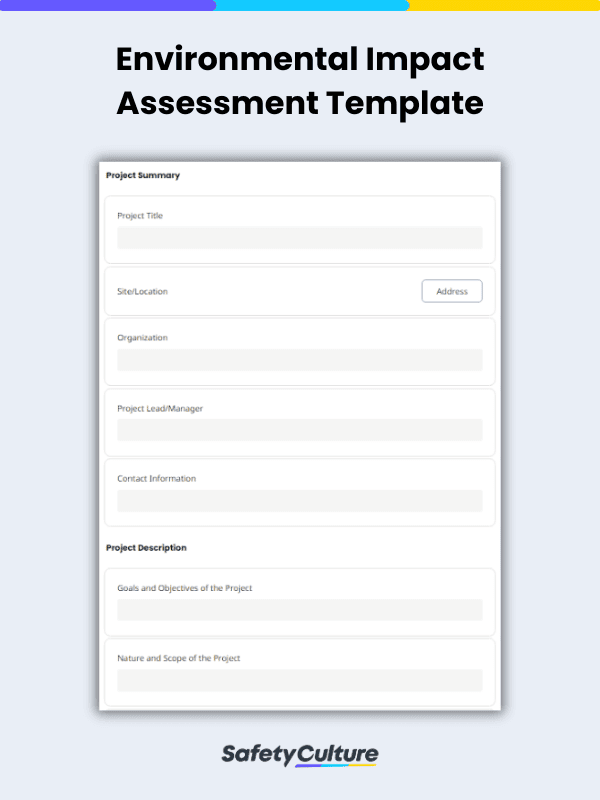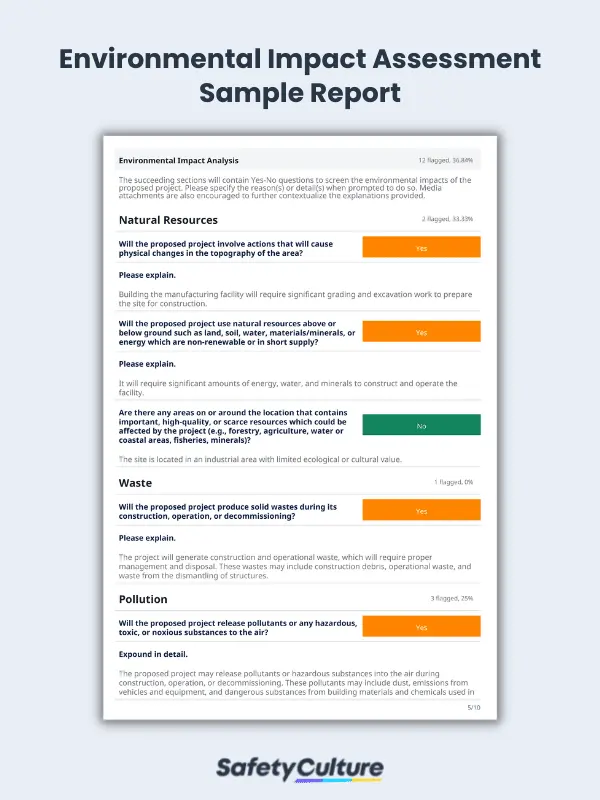What is an Environmental Impact Assessment Template?
An environmental impact assessment (EIA) template is a framework used to standardize the process of determining and evaluating the effects of a proposed project on the environment. It specifies the scope, criteria, methodology, and other components for looking into environmental conditions before proceeding with the project.
What is an Environmental Impact Assessment?
An environmental impact assessment is the process of reviewing the project’s potential impacts on the environment and its surrounding communities before its approval. Identifying these risks allows organizations to establish measures to mitigate and manage them effectively. Moreover, it also ensures that projects comply with relevant environmental laws, policies, and regulations to avoid penalties, fines, and project delays.
Why Use a Template for Environmental Impact Assessments?
An EIA template is a helpful tool for efficiently conducting environmental impact assessments. For one, it gives project developers a framework to capture and present vital information in a clear and organized manner. This way, they can save time and resources compared to creating an EIA report from scratch.
In addition, using templates is key to standardizing EIA documentation practices for consistency and compliance with environmental laws. This practice also promotes transparency with local communities, regulatory bodies, and other stakeholders involved in the project.
What to Include in an EIA Template
An environmental impact assessment template should contain the following information:
- Project Summary – Start the EIA template with the basic details of the project, including its title, location, and the organization and people involved in the process.
- Project Description – Next, define the project’s nature, scope, goals, and objectives. This section can also discuss the timeframe, regulatory requirements, and proposed alternatives.
- Environmental Impact Analysis – Then, screen the environmental impacts of the proposed project by responding to Yes-No questions. It can also include a section to explain the reason(s) for their answers and attach files to support the details provided.
- Discussion of Results – After evaluating environmental indicators, the next step is to state the conclusion found during analysis and recommend actions before starting the project.
- Completion – Lastly, sign off the template with the name and signature of the person who conducted the assessment.
How to Create this Template
Drafting an EIA template can be challenging, but it is crucial for an accurate, complete, and comprehensive assessment. Here is a step-by-step guide on how to create one for your project:
- Define the purpose and scope of the template – Tailor the template to the specific project that it will be used for, including the environmental factors to cover during the analysis.
- Identify the key elements – The components of the EIA template will vary depending on the type of project being assessed. Generally, it will consist of the project description, environmental impact analysis, summary of the assessment findings, and recommended actions to minimize these risks.
- Develop the template structure – An EIA template works best if it’s logical and easy to follow. For example, you can break down the review process into manageable sections using headings and subheadings.
- Collect feedback – Before implementing the template, it’s best to have another set of eyes run through it to identify any issues and check if it works as intended.
- Revise and finalize the template – Based on the feedback from the previous step, edit the template accordingly to improve its usability and effectiveness. Then, once it’s finalized, it can be used for future EIA reports, such as the one illustrated below:
FAQs about Environmental Impact Assessments
Environmental impact assessment templates are typically used by environmental consultants, project developers, and governing bodies responsible for reviewing and approving projects. They serve as a guidance document when conducting environmental impact assessments to be submitted to the authorities for approval.
Requiring an EIA template may vary depending on the guidelines and regulations of the specific jurisdiction where the proposed project or activity will take place. Some jurisdictions may require it as mandated by law, while others may deem it optional.
- Not following the instructions – The instructions in the template are there to ensure that the assessment is done correctly. If they aren’t followed as stated, the person filling out the form is more likely to commit mistakes or miss items.
- Ignoring relevant information – Failure to include all details, especially those seemingly unimportant ones, can lead to inaccurate conclusions.
- Failing to consider alternatives – EIAs are performed to assess environmental impacts and discover ways to mitigate or avoid them. Thus, it’s important to consider all possible options and evaluate their potential effects before reaching a final decision.
- Not seeking expert advice – Depending on the complexity of the project, an expert’s advice may be necessary to ensure that the assessment is thorough and accurate.




